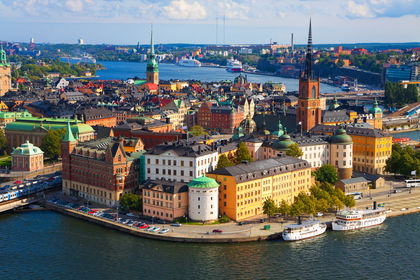SWEDEN

Kingdom of Sweden
Konungariket Sverige
CAPITAL : Stockholm
FLAG : The national flag, dating from 1569 and employing a blue and gold motif used as early as the mid-14th century, consists of a gold cross with extended right horizontal on a blue field.
ANTHEM : Du gamla, du fria, du fjallhöga nord (O Glorious Old Mountain-Crowned Land of the North).
MONETARY UNIT : The krona (K R ) is a paper currency of 100 öre. There are coins of 50 öre and 1, 2, 5, and 10 kronor, and notes of 5, 10, 20, 50, 100, 500, and 1,000 kronor. K R 1 = $0.1201 (or $1 = K R 8.33) as of May 2003.
WEIGHTS AND MEASURES : The metric system is the legal standard, but some old local measures are still in use, notably the Swedish mile (10 kilometers).
HOLIDAYS : New Year's Day, 1 January; Epiphany, 6 January; Labor Day, 1 May; Midsummer Day, Saturday nearest 24 June; All Saints' Day, 5 November; Christmas, 25–26 December. Movable religious holidays include Good Friday, Easter Monday, Ascension, and Whitmonday.
TIME : 1 PM = noon GMT.
FLORA AND FAUNA
Vegetation ranges from Alpine-Arctic types in the north and upland areas to coniferous forests in the central regions and deciduous trees in the south. Black cock, woodcock, duck, partridge, swan, and many other varieties of birds are abundant. Fish and insects are plentiful.
ETHNIC GROUPS
The Swedes are primarily Scandinavians of Germanic origin. There is also a small the Lapp (Sami) population. The remaining 12% of the population is comprised of foreign-born or first-generation immigrants, including Finns in the north, Yugoslavs, Danes, Norwegians, Greeks, and Turks.
LANGUAGES
Swedish is a national language. In addition to the letters of the English language, it has å , ä , and ö . Swedish is closely related to Norwegian and Danish. Many Swedes speak English and German, and many more understand these languages. The Lapps speak their own language. There is also a spread of Finnish-speaking people from across the frontier.
DEPENDENCIES
Sweden has no territories or colonies.
BIBLIOGRAPHY
Anderson, Ingvar. History of Sweden. New York: Praeger, 1969.
Bengtsson, Frans G. The Long Ships. Glasgow: William Collins Sons and Co., Ltd., 1984
Childs, Marquis. Sweden: The Middle Way on Trial. New Haven and London: Yale University Press, 1980.
Einhorn, Eric, and John Logue. Welfare States in Hard Times: Problems, Policy and Politics in Denmark and Sweden. Kent, Ohio: Kent Popular, 1982.
Elstob, Eric. Sweden: A Popular and Cultural History. Totowa, N.J.: Rowman and Littlefield, 1979.
Esaiasson, Peter. Representation from Above: Members of Parliament and Representative Democracy in Sweden. Aldershot, England: Dartmouth, 1996.
Fant, Kenne. Alfred Nobel: A Biography. New York: Arcade, 1993.
Hadenius, Stig. Swedish Politics During the 20th Century. 2d ed. Revised. Swedish Institute, 1988.
Heclo, Hugh and Henrik Madsen. Policy and Politics in Sweden: Principled Pragmatism. Philadelphia: Temple University Press, 1987.
International Smoking Statistics: A Collection of Historical Data from 30 Economically Developed Countries. New York: Oxford University Press, 2002.
Linner, Birgitta. Sex and Society in Sweden. New York: Praeger, 1967.
Micheletti, Michele. Civil Society and State Relations in Sweden. Brookfield, Vt.: Avebury, 1995.
Milner, Henry. Sweden: Social Democracy in Practice. New York: Oxford University Press, 1989.
Moberg, Vilhelm. A History of the Swedish People: From Renaissance to Revolution. New York: Pantheon Books, 1973.
Puffendorf, Samuel F. The Complete History of Sweden, 2 vols. Folcroft, Pa.: Folcroft Library Editions, 1977.
Remaking the Welfare State: Swedish Urban Planning and Policy-Making in the 1990s. Edited by Ingemar Elander, Abdul Khakee, and Sune Sunesson. Brookfield, Vt.: Avebury, 1995.
Roberts, Michael. The Age of Liberty: Sweden, 1719–1772. New York: Cambridge University Press, 1986.
——. Gustavus Adolphus. 2d ed. New York: Longman, 1992.
Rothstein, Bo. The Social Democratic State: The Swedish Model and the Bureaucratic Problem of Social Reforms. Pittsburgh, Pa.: University of Pittsburgh, 1996.
Ruden, Bengt, and Villy Bergstrom (eds.). Sweden: Choices for Economic and Social Policies in the 1980s. Winchester, Mass.: Allen and Unwin, 1982.
Sandelin, Bo (ed.). The History of Swedish Economic Thought. London; New York: Routledge, 1991.
Sather, Leland B. Sweden. Santa Barbara, Calif.: Clio, 1987.
Scobbie, Irene. Historical Dictionary of Sweden. Metuchen, N.J.: Scarecrow, 1995.
Scott, Franklin Daniel. Sweden, the Nation's History. Carbondale: Southern Illinois University Press, 1988.
Sundelius, Bengt (ed.). The Committed Neutral: Sweden's Foreign Policy. Boulder, Colo.: Westview Press, 1989.
i LOVE this site!!
I am doing a project on sweden and this is the best site so far!
No disrespect, but your website does not appear as very up to date...